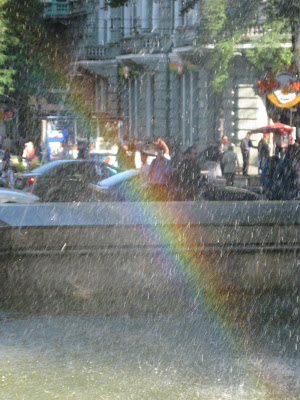



 Above, Elaborately carved entrance Khan's palace, Bakchysaray; Opulent gilded and painted ceilings with sparkling crystal lights, Khan's palace and Odessa Opera House. Collage: Budapest's Grand bazaar tower and a wrought iron gate; Krakow windows; tile work, Uspensky church, Bakchysaray; Budapest Opera house; Tatar Biblioteca, Simferople, Crimea; entrance to the harem, Khan's palace, Bakchysaray. Mosaic with elegant surround, Uspensky church.
Above, Elaborately carved entrance Khan's palace, Bakchysaray; Opulent gilded and painted ceilings with sparkling crystal lights, Khan's palace and Odessa Opera House. Collage: Budapest's Grand bazaar tower and a wrought iron gate; Krakow windows; tile work, Uspensky church, Bakchysaray; Budapest Opera house; Tatar Biblioteca, Simferople, Crimea; entrance to the harem, Khan's palace, Bakchysaray. Mosaic with elegant surround, Uspensky church.
I used to dislike details. Now I feel just the opposite. I wish I knew then what I know now. It would have saved a lot of grief: those "sharps and flats" of past remembrances, as Mary Oliver calls them. But that was then, this is now, and it's all we have, the Erich Tolle mantra. Today I'm thinking about details.
Details engulf us. There are the details of daily life: What to wear or eat. Who to see or meet. What to do that's neat. There are the details of work life: How to write that grant, where to shelve those books, how to lead that seminar. There are the details of decision-making: Should we cancel the meeting? Add new members to the book team? Ask school teachers to help with that Democracy grant?
And then there are the kinds of details I have come especially to love: architectural details. I am usually overwhelmed by the larger picture. By the grand opera house. The beautiful cathedral. The magnificent legislative hall. The elegant presidential palace. The palaces of Kings and Queens, Khans and Shahs, Emperors and Tsars. I have hundreds of great photos to prove this.
But when I stop and look at the details, then I become engrossed. Not overwhelmed, but engaged. The devil is in the details, they say. I think that's true, and I’ve been bitten hard when ignoring that maxim. Beauty is in the details, too. In everyday details, yes, and most of all in those architectural details. I’m thinking about the craftsmanship, the talent, the patient devotion, the work ethic, the artisanal traditions, the pride.
Take the blue mosaic of a Monk above right. It is from the little Uspensky Cathedral with the glistening golden dome built in the mountain caves of Bakchysaray, Crimea. At the ends of the earth, almost. Who will see it? But some craftsman didn't care about that. Instead he put a lot of work into this lovely mosaic in this far-away place, tile by tile, piece by piece. A master stonecarver chisled the frame around it, also a beautiful piece of artwork. They emerged from contemplation, these details, and they invite contemplation.
Wherever I travel now, I marvel at windows and doors, many intricately tiled, painted, or carved, many surrounded by gargoyles, nympths and angels, birds and leaves, and bas reliefs. And beyond the details of the windows, those in and around buildings; be they homes or palaces, cathedrals or theaters, sacred or profane, the details fascinate.
And it's no wonder. The crafts people of old stayed with their tasks for years. It took ten or 20 or more years for Italian stonecarvers to carve the gargoyles around the National Cathedral in Washington, DC, for instance, chipping away, little by little, day after day,month after month, until a form emerged from stone, from marble, from alabaster. Devils and angels, animals and birds, human and inhuman, symbolic or imaginative, mad, sad, or happy. An award-winning documentary, The Stonecarvers, tells the story (funded by the DC Humanities Council, an NEH affiliate).
It's the same with the stained glass windows of churches, cathedrals, temples and mosques, in the Blue Mosque and in St. Sophia's in Istanbul, St. Andrews church in Kiev, the Kainite Jewish temple and St. Nicolas Cathedral in Yevpatoria. The light that streams through these beautiful windows cast a heavenly glow onto grand spaces. And on top of these, literally and figuratively, hang the ornate and ornamental glass work of crystal lights and chandeliers. Like those lights illuminating beautifully painted ceilings in the photos above. Or the Venetian crystal chandelier adorning the carved mahogany wainscotting in the State room of Livadia Palace in Yalta where Stalin, Roosevelt and Churchill met. I love this tradition, too, the ancient art of glassmaking, foretelling modern American glass artists like Tiffany, Dominic Labino of Toledo and Dale Chihuly of Seattle.
And then there are the exquisite paintings, among my favorite details, covering walls and ceilings, furniture and grand staircases. So rich in detail, so vibrant the colors, so angelic the adorers, so passionate the love scenes. I used to think Michelangelo's awesome paintings at the Vatican were unique to the art world, to religious art especially. And of course they are. But he is not alone. Far from it. He had his predecessors and his successors all over the world. Countless Micheangelos in every country, across the ages, across time and faiths, painted temples, mosques, and churches, in India and in Katmandu, created well before the Renaissance, and also here in Ukraine and in Crimea, in Budapest and Krakow, in magnificent Istanbul, Ancient paintings adorn ancient walls. What glorious gifts to the gods, anywhere, any time, any place.
So here’s to glorious details. My latest toast: “Za Подробнее" [Podrobneyeah, in a rough transliteration]. Here's to tiles, and gargoyles, and ancient lights. Here's to dreamy paintings and heavenly stained glass. Here's to wrought iron railings under starry nights. Here's to intricate marble carvings and mosaic delights.










